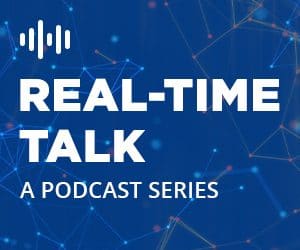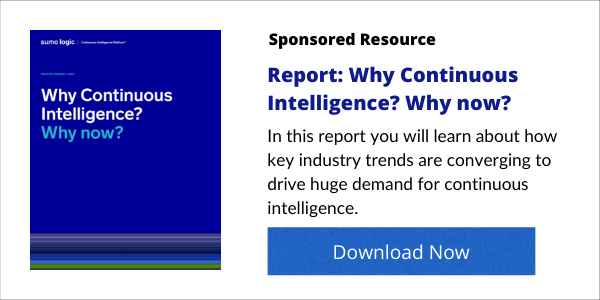
Joe McKendrick, RTInsights Industry Insights Editor, and David Linthicum, Managing Director and Chief Cloud Strategy Officer at Deloitte, discuss the increased need for continuous intelligence in today’s tech-ladened modern world.
In this RTInsights Real-Time Talk podcast, Joe McKendrick, RTInsights Industry Insights Editor, and David Linthicum, Managing Director and Chief Cloud Strategy Officer at Deloitte discuss growing dependency on technology in our personal lives and business. With everything from ride sharing to supply chains, consumers and enterprises need access to instantaneous information to base decisions. Thus, the need for continuous intelligence that lets individuals and corporates find out what’s going on and why.
About the Continuous Intelligence Insights Center:
From real-time fraud prevention to enhanced customer experience to dynamic energy load balancing, businesses of all types and sizes are realizing the benefits of Continuous Intelligence, helping them make decisions in real-time while events are happening.
Where do you begin, though?
What are the key requirements?
RTInsights’ Continuous Intelligence Insights center, sponsored by Sumo Logic, brings together the latest insights and advice on continuous intelligence to answer these questions and more.
Read the podcast transcript:
Joe McKendrick: Welcome everybody. This is Joe McKendrick, an analyst with RTInsights, and I’m very pleased to be joined in today’s podcast on continuous intelligence by David Linthicum. And David, this is such an incredible honor to have you here. I mean, we could go over your resume, but that’s going to take up the entire time of the podcast.
David Linthicum: Yes, I’m old.
Joe McKendrick: You’ve done so many impressive things. Currently your Chief Cloud Strategy Officer with Deloitte, right? Among your many other activities.
Download Infographic Now: The 5 intelligence gaps curbing your climb to digital successDavid Linthicum: I’ve been there for four years, and I am honored to be on your podcast. I mean, I’ve been following you in Forbes, and over the years, how long have we even known each other? Probably 25 years at this point.
Joe McKendrick: Is it that far? 25 years? In the days of client-server.
David Linthicum: I think we were first talking about cloud. No, I knew you in the SOA days. So those are probably the 2002 timeframe when I was a CTO and trying to get the SOA stuff and the cloud stuff off the ground, and no one cared. So, it was a few of us who were writing and speaking about it, and you were one of the few, at least one of the few, who made sense. It turned out you’re not crazy.
Joe McKendrick: Good to know.
David Linthicum: I’ve always viewed you as someone who’s kind of a foot ahead of everybody else in the
marketplace and from an analyst point of view. So, I’m glad to be here.
Joe McKendrick: That’s an honor hearing that from you, David, and you’ve always been leading the chargeback in the service-oriented architecture days. You moved in the cloud, and you’ve been the thought leader, the go-to thought leader in terms of cloud, and you’re continuing that work into this digital era with Edge, Cloud, and digital transformation. I mean, you’re the go-to guy. I say to people, there’s lithium, that powerful energy source that’s powering every device across the planet, but there’s also an even more powerful energy source, and that’s Linthicum.
David Linthicum: Yes. It sounds light. A lot of people pronounce my name lithium, and I think it’s a psychotropic drug too. So, it’s a lot.
Joe McKendrick: Yeah, there’s that too.
David Linthicum: There’s one side versus the other. No, I appreciate that. I enjoy working in this business and trying to stay ahead of everybody. And so it’s fun doing it because just watching the technology evolve, people fear change, I fear not changing. Always look at the next generation where the technology’s going. What’s the value going to be for the enterprises? What kind of IP intelligence do we need to create around leveraging this technology? It’s a challenge, and I love it, and I guess you do too, based on the number of things that you write and speak about.
Related: Digital Complexity and How to Address It
Joe McKendrick: It’s a great market. What I enjoy about it is the optimism. There’s the feeling that we can really change the world for the better, and you’re seeing it across the globe in every continent. Technology has really been a force for change for improving people’s lives, not only their work lives but their personal lives and society. Tech gets its knocks, of course, but I think it’s really been a force of good, a powerful force.
David Linthicum: Companies that are next generation are all about technology. If you look at what we have today, we have ride-sharing companies; they don’t own a single car. We have home-sharing companies; they own a single piece of real estate. And I think that’s going to go on. People are able to weaponize technology to kind of take things to the next level, and if you’re unwilling to do that and take some risks, I think a lot of them are going to fall by the wayside. I mean, I wrote an article a couple of years ago called the brand-apocalypse, which is unusual for me because it was more business-oriented, in the spirit of Harvard business and things like that. But I kind of talked about the number of companies that are whistling past the graveyard in terms of disruptors coming up behind them.
Where it’s going to be a ride-sharing service, and you’re a taxicab service in a larger town. I think they can be a disruptor under themselves and certainly, at their size and mass, the amount of resources they’re able to spend, they just have to take technology and use it in a correct way. And by the way, you need to start now. This is something you can’t suddenly realize that someone’s going to eat your lunch.
When you’re trying to do a digital transformation into whatever is, you’re able to weaponize your
existing business.
I think the proactive thinking about this right now is what’s going to save a lot of these brands from just kind of falling by the wayside. We’re going to see brands that have been around for 200 years go away. They’re not going to go out of business, but we’re going to see them subsumed in other brands and some of the smaller players going to pick them up. In reality, all you need to do is provide a better product and better customer experience, like we can do with electric cars these days and some of the new engines in the marketplace. And you’re going to end up growing in the market rapidly and displacing some of the existing players that are a bit more bloated than they should be and aren’t leveraging technology to the degree they should be.

Joe McKendrick: And the barriers to entry are so low these days.
David Linthicum: Oh yeah.
Joe McKendrick: Yeah. I mean, someone sitting in an office or their home can create something new for the world, right?
David Linthicum: Yeah. Back in the startup days, it was $10 million to get systems in a data center and up and running. Now it’s a thousand dollars a month, and by the way, you don’t need office space because everybody’s going to work out of their laptops wherever they want to exist. You can create these virtual companies that are 20 times more effective than what we had to do back in the brick-and-mortar days. It’s exciting because it levels the playing field and allows people to punch above their weight, and it really allows people to live their ambition out without any hindrances. You don’t have to go out there and get huge amounts of funding to move these things. You can start it an organic way, and I’m seeing these things all the time, and they just make me smile. Just the fact of the matter is that we still have that entrepreneurial ship out there. We still have an innovative nature. People are surprising us all the time and what they can do with the technology. And it’s going to be an amazing time in the next 20 years. I just hope I’m around for it.
Joe McKendrick: Amen to that. Well, let’s talk about something that everybody, as we move into this tech world, continuous intelligence, and the need not only to understand what’s going on in your markets but also understand what’s going on internally and within your organization. How important is it these days to have a system or a DNA, if you will, of continuous intelligence letting you know what’s going on across your enterprise and why now if that’s the case.
David Linthicum: Well, it’s going to be the engine that’s really going to get to the problems that we just brought up. In other words, if you have continuous intelligence, I’m able to see every piece of information that’s analyzed in a certain way, that’s going to be consumable into core processes, and I’m able to leverage in real-time. Back in the day, we had data warehousing, and we had big honking piles of databases. And, it took a day to run a report against those things, things like that. That’s non-actionable data; that’s non-actionable intelligence. So continuous intelligence is about externalizing all of that information, not only the information but putting it in the right analytical context. In other words, removing the information you don’t need and only the information you do need remains; we’re able to analyze that stuff in a matter of nanoseconds and then put that back in the business.
Related: What Makes Cloud Observability Critical and Different?
So, we can deal with supply chains, and we can deal with customer order entry systems. We can deal
with a lot of the things that are frustrating people today in dealing with a business with almost perfect information. Back in the 90s, we wrote about EAI and certainly the service-oriented architecture. And we had this notion of the zero latency enterprise, where an enterprise could have access to any information, any time, for any reason and any kind of an analytical way and brought to some sort of an intelligent angle and embed those things in these core processes. We have this event-driven business, which is completely a hundred percent automated, and now we have the capability of doing it. Number one, we’re able to leverage cloud and other commodity processing, which is able to bring this intelligence to us.
We have the continuous intelligence platforms that are out there that know how we’re going to move this information and how we’re going to maintain it on the fly. Then we have people who have the vision enough to plug these into certain processes within the organization so we can have a zero inventory supply chain; even those are very difficult to do. We can manufacture something at a 20% less cost, we can provide a customer experience far superior to any of our competitors out there, and so this is the weapon we were talking about that people need to take to war, to become a disruptor instead of being disrupted.
Joe McKendrick: I noticed that services such as Uber, for example, you know right away where your car is, if your car is five minutes away or two minutes away, we’re coming around the corner, you’re notified that, and you know that right away. That’s an amazing capability to have.
David Linthicum: Yeah. And it goes to the customer experience. We like to be in control. So I always find I order from folks that are able to tell me exactly where my package is, who’s going to deliver it, what time it’s going to show up, even the driver that’s going to be delivering it. It doesn’t matter if it’s a food delivery service or something else. And we expect these sorts of automation where they didn’t exist ten years ago. We were okay with calling a cab and having it show up sometime in the next two hours or never show up, but not the ability to figure out who accepted the ride, who’s monitoring where they are, how they’re going to get to you, all these sorts of things, being able to communicate with them as ongoing. And that kind of raises the experience up, I’m involved, I’m bought into those experiences, it’s not frustrating me, it’s basically working for me.
Now do the same thing with the pharmaceutical industry, the same thing with the automobile manufacturing industry, the same thing with banks and finance, and we kind of get where things are going. The more you have this intelligence that’s embedded into these processes, the more you can determine the current states and the more you can communicate those states back to the human beings, whether it’s a customer, an executive, or someone who’s operating the business, the better that business is going to run. More importantly, the more attractive that business is going to be to customers who basically vote with their dollars every day. We talked about the big disruption. I think this is what it’s going to be. It’s going to be those who get this; we’re able to weaponize continuous intelligence and other technologies to digitally enable their enterprise to become more real time in nature and those that don’t. The customers, including myself and yourself and everybody else who’s voting with their dollars every day, are going to choose to deal with the more innovative, the more automated, and the more in-the-know companies that are able to do this stuff in real-time. Again, exciting.
Joe McKendrick: It is. And does this intersect, does this dovetail with what’s going internally in the enterprise as well? The ability to know what’s going on with your systems, if there are problems, bottlenecks, or glitches and the way the data is moving or things are happening within your company.
David Linthicum: Yeah, I’m smiling because I get complaints from CEOs and CFOs all the time that they have no idea what’s occurring within the business and that they get reports about once a month, which will tell them disturbing stuff that they really needed to know 30 days ago, and they can’t act upon it, it’s kind of too late to make happen. So the externalization, we’ve had this notion for a long time. My first job out of college, I’m almost 60 years old, was as a DSS decision support application analyst, which was getting into executive information systems to push information to people so they can make better decisions. Well, this does that and does it more, because number one, not only does it push information to the executives in the organization and people who are operating the operations managers, the staffers, things like that, people who are working on loading docks, but it’s able to make decisions in real-time on behalf of those humans, so they don’t have to monitor everything.
Download Infographic Now: The 5 intelligence gaps curbing your climb to digital successWe’re people, and we’re not going to look at a computer screen or look at our phones, seven by 24. Having this continuous intelligence, these automated processes, to really kind of take these things on your behalf, then report back to you what occurred, is ultimately what the goal is here. One of the worst things we can do when we try to do this in the data warehousing world is to externalize things to humans and say, well, human, and you have to make this change, you have to go fix this thing if the problem occurred. That’s versus the self-healing processes, and the self-correcting processes, and the ability for the business to run in something that’s almost approaching a hundred percent automated state, it’s never going to be a hundred percent automated. Humans are going to have to be involved, but how we get them involved and how we leverage them strategically for what humans do, and that’s being innovative and creative, is going to be a bit more purposeful than it was in the past. I think that’s what businesses need to look at right now.
In other words, we’re not trying to automate human beings out of it, we’re trying to put human beings into what they do well, and it’s not looking at numbers and graphs that are flying across the screen and going off and figuring out how to fix things. It’s something else to be able to determine why this thing is occurring, what the root cause problem is, how it can be fixed, attempting a fix, reporting the fix back to a human. Even reporting in as part of a larger report to what kind of inefficiencies are moving forward and the ability to deal with maintenance issues and different layers of abstraction up to the executives in the company that have to deal with different layers of information.
But all they’re doing is basically monitoring things. Very much like we do with our car. We have to steer our cars, but it keeps its own temperature, it’s able to know its location, it can keep its braking systems in the way, and it can troubleshoot some of these things, ongoing. The more we remove the humans out of this, and we’re certainly moving to automated driving coming up, the better off we’re going to be, and the better we can be humans and not be bothered with the minutia. I think that’s what the executives are looking for right now. They want to be informed, but they want to have something that’s able to fix the smaller, more tactical problems. That’s probably 90% of what they deal with out there.
Related: New Technology Brings Organizational Challenges
The 10% they can deal with, we can externalize it to a human, but the 90% of the problems we have
automated systems, who’re able to deal with it much better than the humans can and do so in real-time
and interact in both those.
Joe McKendrick: And AI automation, those great tools we have, they need to be working alongside humans then, and we still need to keep a human in the loop at some point.
David Linthicum: It’s funny when I build AI systems, I’m always under impressed by them because I grew up with 2000. Was it 2001 Space Odyssey where how you could interact with them? Now we have chatbots and things like that. I won’t say the A word that is not to be mentioned because it will go off a foot away from my computer. But the reality is, is that AI-based systems are more beneficial for more tactical things in nature, and so we just talked about that, the ability to find a network problem and the ability to come up with a root cause and what that problem is likely based on the learning database of a million events that it may be shared within its infrastructure to figure out what the problem is, and then able to enact a fix.
At least for the short term, we humans need to look over the shoulders of the AI systems to make sure they’re doing the right things. And by the way, the more we do that, the smarter they become; they’re organically smart. So they start off dumb. As I said, I’m always never impressed with them. I start using them. But ultimately, the cool thing is they become smarter and smarter by collecting the training data, and so they know more than I’m able to know based on my experience because they’re able to take their experience, the AI engines experience, along with the experience of maybe a million other AI engines that are gathering the same information and then make decisions with almost perfect information and make the right decisions that humans can’t do.
That’s stepping up to diagnosing a disease, that’s stepping up into treatment, that’s stepping up into
self-driving cars, self-driving trucks, all these things we have coming down the line, these things work now, and they work now because the AI engines are becoming better and better at what they do. We’re just understanding that the more stimulus it’s provided to them, a longer-term vision of AI, the smarter it’s going to be. So we can’t put an AI system out there for a month and go, well, I’m making better decisions then it does, well it’s learning, it’s basically an infant at that point and has to grow its knowledge and grow its data over time and then learn from the data, that’s why they call it training data. And that information can come in, not just from the databases, but coming from the fields now, from the IoT devices.
Related: Are Your Management Capabilities Keeping Pace with Edge?
Whether you’re dealing with maintenance in a factory, or you’re dealing with retail sales, both on-premise, both brick-and-mortar, and online. It’s just going to be a much more powerful way that people are going to be dependent on. It’s funny, people show up with their AI engines to implement them for strategic purposes. In other words, to make a lot of core decisions, I guess they have the how thing in their mind like I did when I first got into it. And by the way, I’m almost 60 years old, and that was my first job also out of college. It was an AI analyst in building list-based systems. We’ve come a long way. But the ability to leverage them for tactical capabilities, the ability to embed them on edge-based systems, the ability to put them near to the data so instantaneous decisions can be made, that isn’t necessarily complex under themselves, but they’re better to be made by an AI system that’s distributed, that’s close to the data, than they are by a human being looking at it and making decisions, and typically mistakes are part of those decisions.
Joe McKendrick: I imagine the systems to hardware, Moore’s Law probably comes to play, the ability to deploy AI closer to edge systems. We’re able to actually have these devices provide support. I mean, to some extent, our mobile phones support AI, right?
David Linthicum: Yeah. There’s nowhere where AI can’t run, I mean, it runs on my wristwatch now, and if you have a digital watch, I’m not going to promote any brands, but the thing is, if you have a digital watch, you can have AI capabilities that runs on the edge base systems. AI systems are running within thermostats right now, smaller versions of it that are able to make decisions based on your movement throughout the house and their ability to look at the outside temperature, and they’re looking at the cost of power and making tactical decisions that we typically wouldn’t make because we don’t have time to make them, which can save you hundreds of dollars a month on your bill.
The same thing with your automobiles and the same thing with systems they’re pervasive, they’re embedded, they don’t cost much, there’s a lot of open-source AI systems out there that are excellent and moving forward. But the reality is that AI has to come along with your ability to configure it correctly and your ability to point it at the right problem, that it’s looking to solve, your ability to use it in the right way, and that’s where it has the value. So, in the end, it’s not the fact we’re building a how, where it’s one centralized super brain that’s able to become self-aware in a few years and kill us all. But the ability to put AI systems all over the place and have them basically focus on their tactical task, interacting with one another, but that’s really where the power is. It’s these smaller problems we’re able to look to solve using AI technology where ten years ago, it was uneconomically viable for us to do that because we couldn’t afford the processing power. Here now it is. Some of the AI systems I was thinking about building back when I first got out of college, and this is 1980, $5 were going to be, $20 million just for the initial business system, and we couldn’t afford that. Well, now it’s $20 a month, if that, and so everybody can afford that.
Related: AI: Find the Right Use for Artificial Intelligence
Joe McKendrick: That classic line from 2001, right. He might have been speaking to you, “Dave, I’m afraid Dave.” Hal was speaking to you at that time.
David Linthicum: That’s when Hal had emotions. It was a little concerned at that point.
Joe McKendrick: Great. It’s fascinating stuff. Unfortunately, we don’t have a lot of time with this podcast, so I just want to wrap it up and ask you for your advice. That is your advice to technology leaders, business leaders, those folks listening who want to move forward with continuous intelligence. Share some of your wisdom, please.
David Linthicum: The time to move toward this stuff is now. If you’re a business that doesn’t have a significant investment in leveraging this technology, as well as most of the digital enablement technology out there, clouds, IoT, edge-based computing, things like that, it’s always going to be a different answer as to what you need to do. But you need to start asking those questions now. My bigger concern is not that people are going to fail by over trying, the fact they’re just going to fail by never trying. I’m seeing a lot of organizations out there that are sitting on a dime and waiting for something to happen before they think it’s the right opportunity to throw their hat in the ring and move the thing forward. If you’re doing that, you’re going to end up just kind of falling by the wayside. If you’re a leader in an organization, you’re thinking that not proactively how to leverage this technology as a true force multiplier in the business and take your business to the next level, it’s just not going to happen for you. Start thinking about how to make these moves, or else they’re going to make the moves for you.
Joe McKendrick: As you said earlier, you can’t just sit on your brand and accept the status quo. Things are changing too fast.
David Linthicum: No, whether you’re an analyst, or a writer, or a thought leader, or stuff like that, you got to keep at it and keep punching away. Businesses are the same, and it’s going to be a changing world. It’s not this one transformation, just one and done. It’s ongoing continuous improvement and hopefully continuous improvement using continuous intelligence. See what I did there.
Joe McKendrick: I see that CI equals CI. Okay.
David Linthicum: That’s right.
Joe McKendrick: Fantastic, David Linthicum, thank you very much for joining us for today’s podcast. This has been very enlightening, and we really appreciate you having on. It’s been a real honor.
David Linthicum: Anytime Joe, ask me back. Thank you very much for having me.
Learn more about continuous intelligence, visit CI Insights.
Download Infographic Now: The 5 intelligence gaps curbing your climb to digital success




